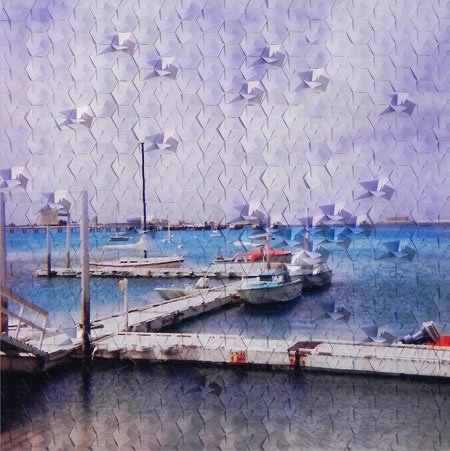
Neuroscience tells us that the path from experience to memory is an imperfect one. A childhood trip to the beach may include sand in our swimsuit, but over time each discordant bit drops by the wayside, and with every retrieval, the narrative is embellished and glossed until the thing we remember is something entirely new. For artist Rusty Scruby, memories of a childhood spent on Kwajalein, located in the Marshall Islands—triggered by a family photo album—provides a starting point to explore his remembrance of things past. That remote atoll, a liminal space between the endless expanse of ocean and a protected lagoon, becomes the inspiration for the current exhibition.
Starting with snapshots from the family album, the artist’s own photographs, prints, drawings, or even plain paper, the images and materials are duplicated from scores to hundreds of times. The product of this is cut, then woven together to create tessellated patterns evocative of everything from a fly’s eye view to the cadence of ocean waves tempered by coral reefs. The less literal source material displays Scruby’s transformation of form to metaphor to best effect. “Reef,” an eight-foot long construction made of interlocking clear and white report covers, transforms at a distance into rain-dappled amethyst waters that segue into white sandy beaches; “Disturbance” weaves together sheets of plain white paper into undulations reminiscent of still waters rippled by a tossed stone.
For the works that are sourced from Scruby’s childhood photos, fractions of images draw the viewer close to search for clues found in the conventions of photographic representation, then quickly pushes us away, searching for a gestalt that can be woven together in the mind’s eye. In “Kwajalien”—the exhibition’s largest work at nearly fifteen feet long—we see the artist’s sister playing to the camera while the artist fades to a blurred cipher in the background. In “Aunti Dotti” Kodachrome colors dazzle while the work’s namesake’s staccato reiterations are read as pure pattern. In one sense moving in close and away becomes a dialog between Roland Barthes’ punctum, defined as the point in a photograph that draws us into the image and makes the work resonate, and Ferdinand de Saussure\'s signified, what the representation manifests in our mind.
Scruby’s Goldberg variations of photographic assemblage in “On The Beach” shows the artist has honed his technique well while expanding the work’s the scope and play. Captured in the both the minor variations inherent in handcrafted work, and the intentional variation in the interlocking patterns are the forgotten details and reinvented moments of a long-past event. In “Kwajalien Rain” a flurry of windswept palms blows over the image of a home on the beach, calling to mind the force of nature—not as a threat—but a source of childhood wonder. While not precise in remembering, Scruby’s finished views are more poetic, thus trumping the mathematics that underpins the work.
